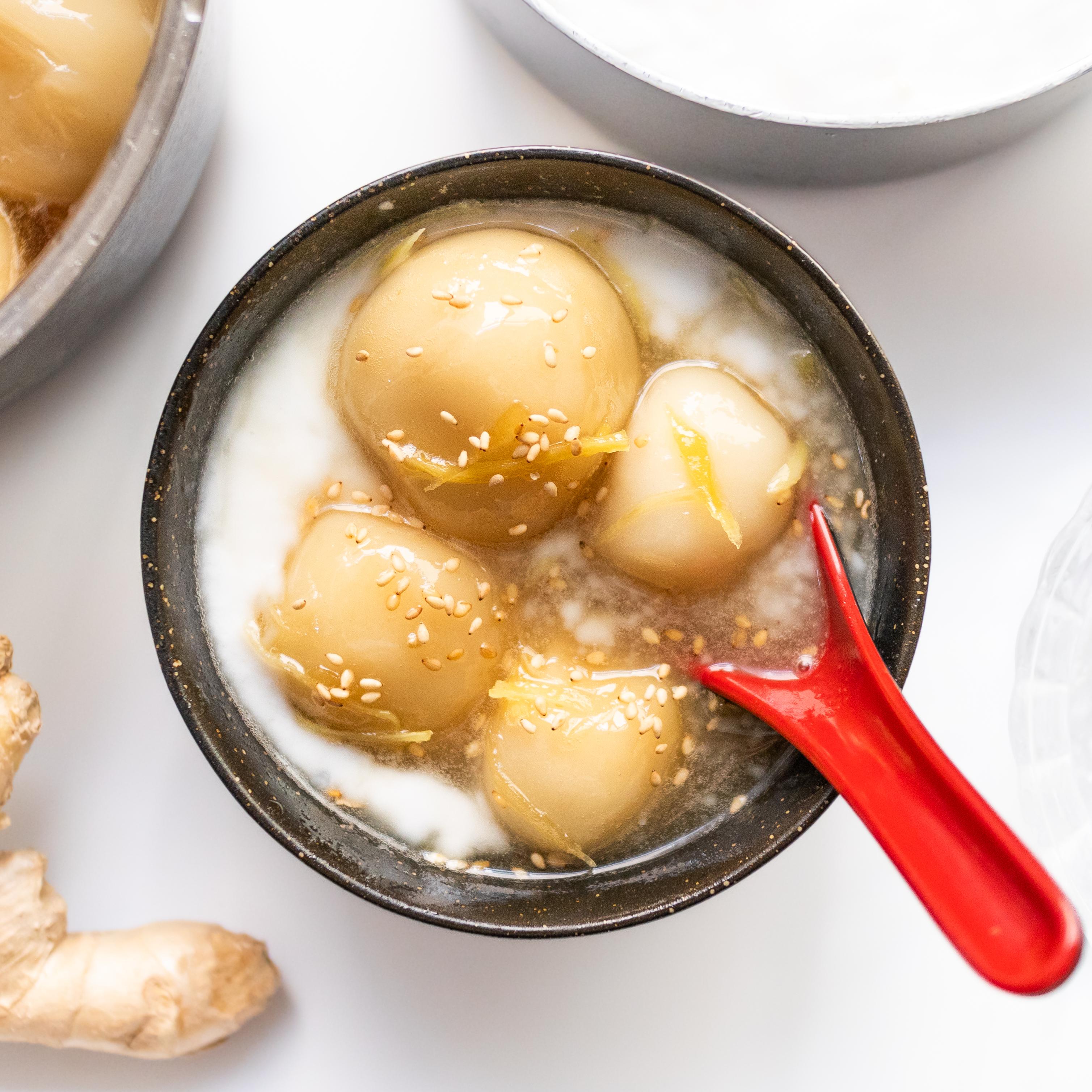
What is Che Troi Nuoc?
Chè trôi nước is a classic Vietnamese dessert often served during celebratory events and important family gatherings.
You’ll see it served on Vietnamese Lunar New Year (Tết), first birthday celebration (Thôi Nôi), or simply enjoy it whenever a sweet craving hits.
These glutinous rice balls, also known as Vietnamese mochi, are served in a warm ginger syrup. It’s a great dessert if you love chewy textures or have extra ginger to use up—or even better, both!

The key to a great bowl of chè trôi nước is having a soft and chewy outer shell (made from glutinous rice flour) with a sweet mung bean filling.
This dessert is very similar to its deep-fried cousin, Vietnamese Fried Sesame Balls (Bánh Cam).

Unlike bánh cam, which is crispy on the outside and enjoyed as a finger food, these glutinous rice balls are simmered in a fragrant, thick ginger syrup.
They are then topped with a creamy drizzle of an optional sweetened coconut milk sauce (nước cốt dừa). It’s chewy, creamy, and so delicious. It’s definitely a reminder of childhood.

What You Will Need
- Glutinous rice flour - Also known as sweet rice powder or mochiko, this is key to chewy rice balls. Do not substitute with regular rice flour; it will not work.
- Hot water - Used to mix with the glutinous rice flour to form a dough. It doesn’t need to be boiling. Hot water from the faucet is ok. The hot water makes the dough more pliable for easy shaping.
- Peeled split mung beans - Used for the sweet filling. They are readily available at Asian markets.
- Salt and sugar - To flavor the mung beans.
- Ginger - Fresh ginger gives the syrup its fragrant, spicy kick and is an absolute must for this dessert. Ground ginger can work in a pinch, but it’s not recommended.
- Palm sugar or brown sugar - Palm sugar is traditional and gives a deeper flavor. Brown sugar is a good substitute if you don’t have palm sugar.
- Sweetened coconut milk sauce - A thick, creamy white mixture of coconut milk, sugar, a bit of salt, and fragrant pandan leaves. This sauce is used for many Vietnamese pudding dessert known as chè and can be made in advance. Find the full recipe here.
- Roasted sesame seeds - Adds crunch and nuttiness as a topping. Find them at most grocery stores or toast raw sesame seeds yourself in a dry pan.

How to Make Che Troi Nuoc

Step 1: Make the Dough
In a large mixing bowl, combine glutinous rice flour and hot water. Mix and knead until you get a smooth dough.
Don’t be tempted to add more water. Keep mixing, and it will eventually come together.
Using a pair of chopsticks or a whisk to get it going has proven to be very helpful. Once it starts to clump together more, use your hands to mix.

Step 2: Make Filling Balls
Rinse the peeled mung beans until the water runs clear.
In a medium pan, add the rinsed mung beans and enough water to cover them by 1 inch.
Cook over medium heat until it boils, then reduce the heat and continue cooking until the beans are softened but still maintain their shape (about 15 minutes). Monitor the pot carefully and reduce the heat as needed to prevent it from boiling over.
Drain the beans and return them to the stove with the heat off to evaporate any residual moisture. Add salt and sugar. Then use a large spoon to smash and mix them into a rough paste. It doesn’t need to be smooth.
If you find that the mixture is too soft to handle and you cannot form it into small balls, chilling it will make it more manageable.
Roll the filling into small balls, about ½ inch in diameter (about 28 pieces).


Be careful not to let the mung bean filling spill out of the wrapper, as cooking it will cause it to leak and the ball will fall apart. There will be no way to save it at that point.
Use any leftover dough to form small balls without filling.

Gently drop the balls into the simmering syrup. Cook gently on medium-low heat until they float (about 20 minutes).


Size Variations & Extra Filling
The great thing about chè trôi nước is that the balls don’t all have to be the same size.
Some can be large, some medium, and some small. Leftover mochi wrappers can be rolled into tiny, unfilled mochi pearls.
If you have leftover mung bean filling, set them aside as an optional topping at serving. Do not cook them in the ginger syrup with the dumplings as they will just fall apart without a casing.

Storage & Reheating
Store any leftovers in an airtight container at room temperature (no more than a day) or in the refrigerator for up to 5 days.
Refrigerated mochi balls may harden. To soften them, reheat on the stovetop or microwave in small intervals until warmed through.
Reheat the coconut milk sauce separately the same way. Combine the mochi balls and sauce when ready to serve.
Print